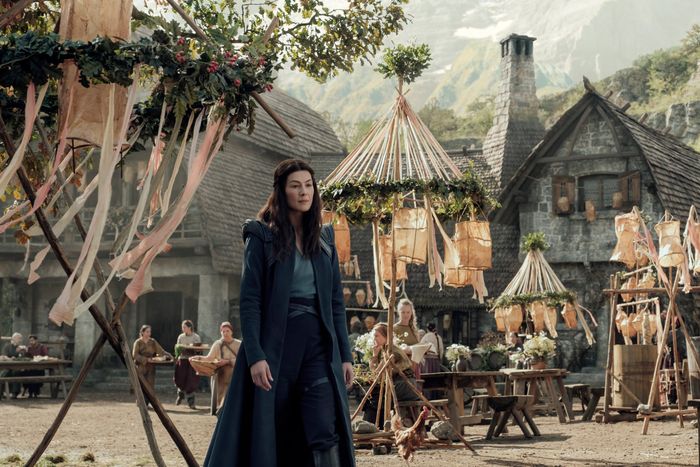
Several episodes into The Wheel of Time, Amazon Prime VideoÔÇÖs enormous adaptation of the similarly enormous Robert Jordan/Brandon Sanderson fantasy series, I cannot stop thinking about how good it looks. All those horses, clip-clopping around the forests. The beautiful inn full of pewter tankards and dark-brown wooden beams and rough-hewn tables to gather around while muttering about rumors of oncoming darkness. The costumes are lovely; the caravan of Tinkers heads across big, beautiful green landscapes pulling colorful wagons with convincingly creaky wheels. Barns look like barns. Towers look like towers. You get the idea.
This detail and extravagance is not a shock ÔÇö Amazon poured money into Wheel of Time. Reporting suggests that it has cost around $10 million an episode, much of it spent on the immense scale of its production design. In a piece for GQ, Wheel of TimeÔÇÖs showrunner Rafe Judkins describes the current mind-set toward production and scale: ÔÇ£One of the crazy things about now is just how ready and willing networks are to just look you in the eye, and you say, ÔÇÿIÔÇÖm going to build the Two Rivers [the village where Wheel of Time begins] and then weÔÇÖre going to burn it down at the end of episode one.ÔÇÖ And theyÔÇÖre like, ÔÇÿGreat. WhatÔÇÖs next?ÔÇÖÔÇØ
There are two different ideas happening here. The first is obvious and shows up all over in movies and TV and art and cars and all of capitalism, basically: Things can be better if you spend more money on them. This is the most gargantuan ÔÇ£duhÔÇØ of all time while also being demonstrably false in a billion different ways, a fact that anyone whoÔÇÖs ever watched a very expensive movie that is also terrible knows intimately. Wheel of Time becomes a valuable TV show by virtue of the explicit value a corporation has assigned to it. It was worth spending money on, which means it has a cultural worth.
The other idea is a little obscured beneath the piles of dollar signs. JudkinsÔÇÖs argument is that Wheel of Time needs hyperrealism as the foundation for the showÔÇÖs fantasy world, an entire village built solely so it can be burned down by a magical monster. ThereÔÇÖs an implicit understanding that everything will be better if itÔÇÖs real, real and huge, if an entire fictional village actually exists and then is actually burned down. And I get it! I love practical effects as much as the next person, love the specific detailing of carefully constructed costumes and the feeling that everyone really is out there in the woods, running around in the mist for a big battle scene. I canÔÇÖt argue that itÔÇÖs not cool to build an entire village and then actually burn it all down, much cooler than it would be to burn a couple houses, or even simpler, to watch the flickering of an offscreen burning village get reflected in two characterÔÇÖs shocked faces.
Except that Wheel of Time also feels hollow, especially in the department of character development and well-defined stakes. ItÔÇÖs hard to stop thinking about how gorgeous it all looks, because there is so little else to really hang onto: Too often, it substitutes physically building a world for narrative world-building. The characters are mostly figurines getting placed in various beautiful dioramas, with little sense of what differentiates this particular Fantasy World Forest from any other franchiseÔÇÖs Fantasy World Forest, what makes this Probable Chosen One distinct from every other wide-eyed, pale-skinned, sweet-looking young man who loves his friends and will try to live up to this great burden. Painstaking production of beautiful set pieces become counterintuitively distracting. The backgrounds are too real; their fictionality is oddly absent.
Yes, yes, I know, thereÔÇÖs a metric ton of narrative world-building in the books, and Wheel of Time is trying to cram all of that into these opening episodes. In many cases, the series does a yeomanÔÇÖs job of collapsing pages and pages of backstory, like condensing buckets of material about the Aes Sedai and how they came to be and why they have different colors and etc. etc. into more clipped, economical dialogue. Still, all of it feels simultaneously overexplained and undermotivated, more like flipping through a giant behind-the-scenes coffee-table book than watching a story play out.
ItÔÇÖs why Wheel of Time has been underwhelming so far. I am fully in awe of its beauty, and I am not immune to the pleasure of knowing that in order to make this show, someone convinced Amazon to turn a pile of money into a village and then immediately set it on fire. But itÔÇÖs also why one of my favorite things about the show is inarguably the corniest: Layered on top of the beautiful interiors built on massive soundstages and the detailed Trolloc costumes and the sumptuous traveling tents, sometimes the band of traveling companions trying to save the world perform magic, and itÔÇÖs proudly CGI. It looks like swirling white or black stuff (for good versus evil!), and it is hands-down the goofiest but also most effective thing about Wheel of Time.
So much of the rest of this series is money used to make everything feel like it could be in our world. And yet all the magical weavings and the silly hand gestures people do to create them, those are the parts when the show feels most like itself. ThereÔÇÖs personality to it. Plus, wouldnÔÇÖt you know it, thereÔÇÖs some pleasure in watching the parts of a fantasy show that are deliberately unreal. I just wish more of Wheel of Time were spent on the magic, because I already know what the real world looks like.


